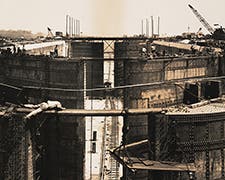Panama Railroad
A Popular Account of the Railroad
Harper’s New Monthly Magazine published an early account of the Panama Railroad a few years after the railroad was completed. Armchair readers who had not been to Panama would have been captivated by the images and descriptions of the railroad and the sites that one could expect to see on a trip across the Isthmus. But to A.B. Nichols, who was familiar with Panama and the railroad from his years of work on the canal, there were many inaccuracies. He made snide comments in the margins of his copy to point them out. Whoever saw “a Panama monkey nearly as large as a man?” he wrote next to one illustration.
Panama Railroad at the Summit, 1855
The Panama Railroad was completed at Summit in 1855, a point about 10 miles northwest of Panama City on the Pacific side. The last rail was laid there on January 27, and the completed line immediately attracted passengers. Robert Tomes was one of them. He published an account of his trip on the new railroad during that first year of its operation. Summit, or Culebra as it was later called, had been for some time the terminus of the railroad while under construction. Its principal feature, Tomes reported, was a “groggery”, where passengers bought bad brandy before continuing by mule to Panama City. Once the railway line was completed, Summit became only a railway station where passengers had barely enough time to buy a few oranges from street venders at exorbitant prices before completing the journey.
As completed in 1855, the Panama Railroad line was about 47 ½ miles long. It started in the town of Aspinwall on the Atlantic side of the Isthmus. Since the town was built as a terminus for the railroad, its main street was the railway line, named Front Street, as it was adjacent to the bay. When Ferdinand de Lesseps and other travelers arrived in Panama, they usually stepped off the ship at Aspinwall, or Colón as it was renamed. They could walk directly from the wharf to the train tracks on Front Street, get on the next train and begin the trip across Panama.
The Atlantic terminus of the Panama Railroad was named in honor of one of the railroad’s founders, William H. Aspinwall, but the name was later changed to Colón, the Spanish form of Christopher Columbus’s last name. For a while, the town had a dual identity, as shown on the early blueprint, which allows for both names. Railroad people preferred Aspinwall, while the Columbian government chose Colón.

